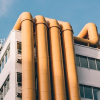A hazardous area is any location where explosive atmospheres may form due to the presence of flammable substances. This can include:
- Flammable Gases (e.g., methane, propane)
- Vapours from flammable solvents or fuels
- Combustible dust (e.g., flour, coal, metal shavings)
These environments are commonly found in industries like mining, oil refining, chemical processing, food production, and grain storage, where materials like methane, propane, solvent vapours, flour, coal dust, or metal shavings can mix with air and create a significant risk of explosion. Understanding what defines a hazardous area and how it’s classified into zones is crucial for ensuring workplace safety and selecting the appropriate explosion proof equipment.


Hazard Zone Classification
In hazardous environments, both flammable gases/vapours and combustible dust can create explosive atmospheres. Industries such as oil and gas, mining, chemical processing, food production, and grain handling are especially at risk. While gas explosions are often more immediate, dust explosions can be just as dangerous, often causing secondary blasts that are even more destructive.
The table below outlines how these hazardous areas are classified into zones, based on the likelihood and duration of explosive atmospheres:
| Zone | Definition | Examples | Equipment Required |
| Zone 0 (Gas / Vapour) |
Explosive gas atmosphere is present continuously or for long periods | Inside fuel or solvent tanks | Intrinsically safe or certified for continuous operation in explosive atmospheres |
| Zone 1 (Gas / Vapour) |
Explosive atmosphere is likely during normal operation | Around flanges, valves, or pumps in chemical plants | Explosion proof or flameproof equipment certified for hazardous areas |
| Zone 2 (Gas / Vapour) |
Explosive atmosphere is not likely during normal operation; short duration only | Properly ventilated areas like paint booths or solvent storage | Certified equipment; less robust than Zone 1 |
| Zone 20 (Dusts) |
Combustible dust is present continuously or for long periods | Inside grain silos, screw conveyors, powder mixing machines | Completely dust-tight and certified for continuous exposure |
| Zone 21 (Dusts) |
Combustible dust is likely during normal operation | Dust near milling, grinding, or bagging operations | Certified enclosures that prevent dust ingress and surface ignition |
| Zone 22 (Dusts) |
Dust is not likely during normal operation; if present, only short duration | Near transfer points or dust-prone areas from leaks | Must meet dust protection standards and have appropriate temperature ratings |
Why Hazardous Area Classification Matters
Correct classification of hazardous areas ensures:
- Regulatory compliance with standards like ATEX, IECEx or UL.
- Safety for personnel and property by preventing ignition sources.
- Appropriate equipment selection, such as explosion proof junction boxes, sensors, or lighting.
- Risk reduction by isolating and minimizing exposure to explosive atmospheres.
Explosion Proof Equipment in Hazardous Areas
To operate safely in hazardous areas, use certified explosion proof or intrinsically safe equipment. This is because standard electrical devices can generate sparks, heat, or arcs that may ignite flammable gases or dust present in the environment, leading to catastrophic explosions.
Essential explosion proof equipment includes:
- Explosion proof junction boxes
- Explosion proof lighting
- ATEX-certified sensors and control panels
- Intrinsically safe communication devices
Each device must be rated for the specific zone it will be installed in. For example, equipment certified for Zone 1 may not be safe in Zone 0, and Zone 21 devices are not suitable for Zone 20 conditions. Matching the right equipment to the right zone ensures both compliance and maximum safety.
At Transtech, we provide reliable, certified explosion proof systems tailored to your application. From explosion proof junction boxes and hazardous area lighting to intrinsically safe barriers and electrical components, our products are designed to meet the highest safety standards in hazardous environments.
Contact us or email info@transtech.com.au to speak with one of our experts. We’ll help you find or customise the right solution for your specific zone and industry needs.







